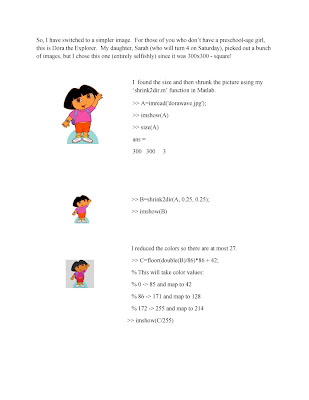
Wednesday, July 2, 2008
Wednesday, June 25, 2008
Monday, June 23, 2008
Friday, June 20, 2008
Thursday, June 19, 2008
Tuesday, June 17, 2008
Photomosaic Diary - June 17
Friday, June 13, 2008
Wednesday, June 11, 2008
Assignment 10
The colour picture:
function [ outpic] = swirl( inpic, r, gamma )
inpic=double(inpic);
cx = size(inpic,1)/2;
cy = size(inpic, 2)/2;
outpic(:,:,1)=zeros(size(inpic,1),size(inpic,2));
outpic(:,:,2)=zeros(size(inpic,1),size(inpic,2));
outpic(:,:,3)=zeros(size(inpic,1),size(inpic,2));
for x = 1:size(inpic,1);
for y=1:size(inpic,2);
d=sqrt((x-cx)^2+(y-cy)^2);
if (d greater than r) or (d less than 1);
inpic=double(inpic);
cx = size(inpic,1)/2;
cy = size(inpic, 2)/2;
outpic(:,:,1)=zeros(size(inpic,1),size(inpic,2));
outpic(:,:,2)=zeros(size(inpic,1),size(inpic,2));
outpic(:,:,3)=zeros(size(inpic,1),size(inpic,2));
for x = 1:size(inpic,1);
for y=1:size(inpic,2);
d=sqrt((x-cx)^2+(y-cy)^2);
if (d greater than r) or (d less than 1);
outpic(x,y,:)=inpic(x,y,:);
else if (y less than cy);

theta = acos((x-cx)/d);
else theta = -acos((x-cx)/d);
end;
fr = (d/r)^2*(1-(d/r))^2*16;
newx=d*cos(theta + gamma*fr)+cx;
newy=d*sin(theta + gamma*fr)+cy;
t=floor(newx);
u=floor(newy);
for k=1:3;
outpic(x,y,k)=[1-newx+t newx-t]*[inpic(t,u,k) inpic(t,u+1,k);inpic(t+1,u,k) inpic(t+1,u+1,k)]*[1-newy+u; newy-u];
end;
end;
end;
end;

The black & white picture:
function [ outpic] = swirlbw( inpic, r, gamma )
inpic=double(inpic);
cx = size(inpic,1)/2;
cy = size(inpic, 2)/2;
outpic=zeros(size(inpic,1),size(inpic,2));
for x = 1:size(inpic,1);
for y=1:size(inpic,2);
d=sqrt((x-cx)^2+(y-cy)^2);
if (d greater than r) or (d less than 1);
inpic=double(inpic);
cx = size(inpic,1)/2;
cy = size(inpic, 2)/2;
outpic=zeros(size(inpic,1),size(inpic,2));
for x = 1:size(inpic,1);
for y=1:size(inpic,2);
d=sqrt((x-cx)^2+(y-cy)^2);
if (d greater than r) or (d less than 1);
outpic(x,y)=inpic(x,y);
else if (y less than cy);

theta = acos((x-cx)/d);
else theta = -acos((x-cx)/d);
end;
fr = (d/r)^2*(1-(d/r))^2*16;
newx=d*cos(theta + gamma*fr)+cx;
newy=d*sin(theta + gamma*fr)+cy;
t=floor(newx);
u=floor(newy);
outpic(x,y)=[1-newx+t newx-t]*[inpic(t,u) inpic(t,u+1);inpic(t+1,u) inpic(t+1,u+1)]*[1-newy+u; newy-u];
end;
end;
end;

Monday, June 9, 2008
Assignment 8 - Q3 & 4
I'm putting these two questions as a separate blog posting since I'm tired of fighting with blogspot and the images.
3. Enlarging using bilinear interpolation approximation.
Here is the Matlab M-file:
function [ largeimage ] = enlargebi( picture, f )
picture=double(picture);
Mp=floor(size(picture,1));
Np=floor(size(picture,2));
largeimage(:,:,1)=zeros(f*Mp,f*Np);
largeimage(:,:,2)=zeros(f*Mp,f*Np);
largeimage(:,:,3)=zeros(f*Mp,f*Np);
for i=0:(f*Mp);
for j=0:(f*Np);
a=i/f;
b=j/f;
r=floor(a)+2; %to get rid of black border (thanks Thomas)
s=floor(b)+2;
if s>0 && s<(size(picture,2)) && r>0 && r<(size(picture,1));
for k=1:3;



Supposedly this appears better than the nearest neighbour method (which might be 'grainier'?)shown below:
As I understand it, Photoshop uses a bicubic interpolation as the default when it scales images. I presume that GIMP does likewise. In Photoshop, with the commands Image -> Resize -> Resample Image it is clear that 'bicubic' is selected unless the user changes the option to either 'bilinear' or 'nearest neighbor'.
3. Enlarging using bilinear interpolation approximation.
Here is the Matlab M-file:
function [ largeimage ] = enlargebi( picture, f )
picture=double(picture);
Mp=floor(size(picture,1));
Np=floor(size(picture,2));
largeimage(:,:,1)=zeros(f*Mp,f*Np);
largeimage(:,:,2)=zeros(f*Mp,f*Np);
largeimage(:,:,3)=zeros(f*Mp,f*Np);
for i=0:(f*Mp);
for j=0:(f*Np);
a=i/f;
b=j/f;
r=floor(a)+2; %to get rid of black border (thanks Thomas)
s=floor(b)+2;
if s>0 && s<(size(picture,2)) && r>0 && r<(size(picture,1));
for k=1:3;
largeimage(i+1,j+1,k)=[1-a+(r-2) a-(r-2)]*[picture(r-1,s-1,k) picture(r-1,s,k); picture(r,s-1,k) picture(r,s,k)]*[1-b+(s-2); b-(s-2)];
end;
end;
end;
end;
end;
end;
end;
end;
image((largeimage)/255);
end
Sample commands:
A=imread('rainbow.jpg');
B=shrinkbi(A, 0.75);
C=enlargebi(A, 4/3);
I don't think that these look right. On other people's blogs the enlarged images come out much clearer than these. But, my commands are the same as theirs, so I don't know why this is happening. The images (shrunk first, then enlarged):
f = 0.75, f = 4/3

C=enlargebi(A, 4/3);
I don't think that these look right. On other people's blogs the enlarged images come out much clearer than these. But, my commands are the same as theirs, so I don't know why this is happening. The images (shrunk first, then enlarged):
f = 0.75, f = 4/3

f = 0.1, f = 10
f = 0.75, f = 4/3
f = 0.25, f = 4

f = 0.1, f = 10

4. Lots of people seem to be saying that the bilinear interpolation does a better job at preserving the resolution when an image is first reduced and then enlarged. As an example, here is the rainbow reduced (f = 0.25) and then enlarged (f = 4) using bilinear interpolation.

Supposedly this appears better than the nearest neighbour method (which might be 'grainier'?)shown below:
As I understand it, Photoshop uses a bicubic interpolation as the default when it scales images. I presume that GIMP does likewise. In Photoshop, with the commands Image -> Resize -> Resample Image it is clear that 'bicubic' is selected unless the user changes the option to either 'bilinear' or 'nearest neighbor'.
Subscribe to:
Comments (Atom)










































